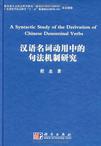汉语名词动用中的句法机制研究
出版时间:2010-7 出版社:科学出版社 作者:程杰 页数:337
前言
中国人重视事物的功能胜过重视事物的形式。举个例子,中国人管所有能载会跑的交通工具叫“车”,如火车、卡车、轿车、三轮车、自行车、手推车等。西方人则不同,他们更注重事物的形式,中国人眼中的各种“车”在他们看来差别非常大,分别被叫做train、truck、car、tricycle、bike、cart等。显然,中国人喜欢根据事物的功能来给事物命名,西方人倾向于根据事物的形式给事物命名。有一外星人造访地球,功能至上的中国人最可能问的第一个问题是“它是干什么的”,崇尚形式的西方人最可能问的第一个问题是“它是什么样的”。接下去,中国人的第二个问题最有可能是“怎样用它干点什么”,西方人的第二个问题最有可能是“它为什么长这样”。再下去,中国人会想方设法把它派上用场,管它长什么样呢;而西方人会死钻牛角尖,非搞清楚它的来龙去脉不可,并创立一门新的学问,叫“外星人形态学”。 中西方这种认知倾向上的差异也反映在对人类语言的态度和研究上。在古代,中国人考字训诂,说文解字,被视为“小学”,研读诸子百家的学说典籍才算“大学”。“小学”为“大学”服务,是应用而生的,具有功利色彩。“小学”是中国从先秦到清朝的整个封建时代主要的以语言为对象的学术活动,勉强算得上“语文学”,还不是真正意义上的“语言学”。而在同一时期,西方人基于古希腊语和拉丁语创立了语法学,热衷于对语言的形式和结构“说三道四”;19世纪兴起的历史比较语言学也是根据语言的形式和结构对亚欧广大地理范围内的多种语言进行历时和共时的比较研究。西方人关注语言的形式和结构,功利性不强,更有“为学术而学术”的味道。到了20世纪,现代语言学随着索绪尔的《普通语言学》的出版而诞生。短短几十年中,西方的语言学研究流派纷呈,有社会学视角的、人类学视角的、心理学视角的、功能主义视角的、形式主义视角的等。可是从50年代起,随着乔姆斯基的生成语法理论的问世,形式主义的语言学研究成了西方语言学研究的主流,这一传统一直延续到今天。现代语言学比较系统地被引进中国主要是改革开放以后。
内容概要
汉语名源动词可以从“构词—句法”的角度得到合理的分析,该分析选取的理论框架包括一条显性的句法操作和两种轻语类。前者是指动词补语并移,即动词中心语移位时,可能连带其补语中除指示语外的部分并移;该操作作为一种选择性的动词移位方式,在一定的允准条件下发生,得到广泛的经验支持。后者包括元动词和虚介词。元动词独立于核心功能语类口和助动词,和普通实义动词同属词汇语类V;虚介词是一种连接不及物动词与其后名词性成分的语类。 根据Vendler(1967)的事态类型,汉语名源动词可分为状态类、成就类、完成类和活动类四种,每一类名源动词都通过动词补语并移这一显性句法操作而生成,该操作涉及一个或一个以上处于动词中心语位置V的元动词和动词短语VP的补语位置上以一个虚介词为中心语和源名词为补语的介词短语PP。四类名源动词的推导所涉及的元动词的种类和数量有所不同,但推导所依赖的句法结构和句法操作是一样的。基于轻语类的动词补语并移对汉语中的名词动词化现象提供了简洁、统一和系统的解释。 汉语名源动词的句法推导为以下相关现象提供了解释:①状态/成就类名源动词与完成/活动类名源动词在数量上的不对称以及名词和形容词在动词化方面的语类不对称;②名源动词的体态变化的模式;③完成类动词在汉语中的存在;④元动词对名源动词体态的决定作用;⑤名源动词的事态结构的合成性;⑥名源动词的语义生成。 现代汉语和英语在名源动词方面存在三项差异:数量上不对称(即现代汉语中的名源动词比英语少许多);类型上不对称(即英语中一些类型的名源动词在现代汉语中不存在);体态上的不对称(即现代汉语中名源动词的体态特征与源名词的语义特征没有关联,而英语中名源动词的体态特征与源名词的语义特征有关联)。这些不对称现象归因于虚介词P、元动词和动词补语并移的参数变化。三个参数赋值的综合决定了现代汉语名源动词和英语名源动词之间的差异:前者的生成受句法制约;后者不受句法制约,仅遵循一形态规则N—V。正是这一差异造成了现代汉语和英语的名源动词之间的三种不对称现象。 古代汉语中的名源动词在数量和类型上接近英语,而在体态方面则接近现代汉语。尽管虚介词P、元动词和动词补语并移在古代汉语句法中的表现与在现代汉语中没有明显的区别,基于轻语类的动词补语并移仅适合于现代汉语名源动词的推导,而不适合古代汉语名源动词的推导。为消解这一悖论,本书提出一种体现最简句法精神的解释。根据该解释,汉语允许由句法特征、语义特征和零语音特征组成的语素或语类,即轻语类,如元动词和虚介词;而英语则不允许这种语类。轻语类在古代汉语中属于强语类,仅局限于“构句—句法”操作;但在现代汉语中它们属于次强语类,既接受“构句—句法”操作,又接受“构词一句法”操作。这两种参数变化合起来就可以整齐地解释现代汉语、古代汉语和英语在名源动词方面存在的对称和不对称现象。
书籍目录
序AcknowledgementsAbstract摘要GlossaryChapter I Introduction 1.1 Introduction 1.2 Denominal Verbs in Chinese 1.2.1 The Criteria 1.2.2 The Data 1.2.3 Semantic Properties of DNVs 1.3 Previous Approaches to DNVs 1.3.1 The Lexical/Morphological Approach 1.3.2 The Pragmatic Approach 1.3.3 The Lexical-semantic Approach 1.3.4 The Syntactic Approach 1.3.5 Summary 1.4 Rationale for This Research and Questions to Be Addressed 1.5 A Syntactic Approach to Chinese DNVs: An OverviewChapter 2 The V-bar Pied-piping Hypothesis 2.1 Introduction 2.2 The V-bar Pied-piping Hypothesis 2.2.1 Dative Shift Under Current Theories on Verb-related Movement 2.2.2 The V' Reanalysis Hypothesis 2.2.3 The V-bar Pied-piping Hypothesis 2.2.4 Licensing V-bar Pied-piping 2.3 Explaining Some (A)symmetries of Syntactic Domains 2.4 Explaining Some Natural Word Order Phenomena 2.4.1 Adjuncts. 2.4.2 Verb Particles 2.4.3 Extraposition 2.4.4 Inversion 2.5 Deriving Compound Verbs in Chinese 2.5.1 Verb-Directional/-Phase Constructions in Chinese 2.5.2 Verb-Resultative Constructions in Chinese 2.5.3 Light Verb Constructions in Chinese 2.6 SummaryChapter 3 Semantic Light Categories in Chinese 3.1 Introduction 3.2 Light Verbs: Syntactic vs. Semantic 3.2.1 The Meanings of Light Verb 3.2.2 Light Verb v vs. Proto-verbs 3.2.3 Proto-verbs vs. Canonical Verbs 3.2.4 Auxiliary Verbs. 3.3 Null Prepositions in Chinese 3.3.1 Variety and Unselectiveness of Verbal Objects 3.3.2 The Null Preposition Hypothesis 3.3.3 Some Consequences 3.4 SummaryChapter 4 Syntactic Derivation of DNVs 4.1 Introduction 4.2 Reclassifying DNVs in Chinese 4.2.1 Aspectual Classes of Verbs 4.2.2 Aspectual Classes of Chinese DNVs 4.3 Deriving DNVs via Syntax 4.3.1 Deriving Sta-DNVs 4.3.2 Deriving Ach-DNVs 4.3.3 Deriving'Acc-DNVs 4.3.4 Deriving Act-DNVs 4.4 SummaryChapter 5 Syntax-Induced Properties of DNVs 5.1 Introduction 5.2 The Inter-Class Quantitative Asymmetry 5.3 The Inter-Categorical Asymmetry 5.4 The Pattern of Aspectual Shift with DNVs 5.4.1 State-to-Achievement Shift 5.4.2 Achievement-to-Accomplishment Shift 5.4.3 Accomplishment-to-Achievement Shift 5.4.4 Achievement-to-State Shift 5.4.5 Some Caveats 5.5 Accomplishment Verbs in Chinese 5.5.1 The Traditional View 5.5.2 Object-coerced Accomplishment Verbs 5.5.3 Syntactically-derived Accomplishment Verbs 5.6 Determination of the Aktionsart of DNVs 5.6.1 Definiteness of Objects 5.6.2 Boundedness of Objects 5.6.3 Boundedness of Source Nouns 5.6.4 Proto-verbs 5.7 Eventuality Structure of DNVs 5.7.1 The Singular-headedness of Sta- and Act-DNVs 5.7.2 The Double-headedness of Ach-DNVs 5.7.3 The Triple-headedness of Acc-DNVs 5.8 Semantic Generation of DNVs. 5.8.1 The Basics of Generative Lexicon 5.8.2 Generating the Semantics of Sta-DNVs 5.8.3 Generating the Semantics of Ach-DNVs 5.8.4 Generating the Semantics of Acc-DNVs 5.8.5 Generating the Semantics of Act-DNVs 5.8.6 Functioning of Proto-verbs 5.9 SummaryChapter 6 A Comparative Perspective on DNVs 6.1 Introduction 6.2 Asymmetries Between Chinese and English DNVs 6.2.1 Quantitative Asymmetry 6.2.2 Typological Asymmetry 6.2.3 Aspectual Asymmetry 6.3 Potential Parametric Variations 6.3.1 Activity vs. Inertness of Null Preposition 6.3.2 Prominence vs. Dormancy of Proto-verbs 6.3.3 Applicability of V-bar Pied-piping 6.4 The Account for the Asymmetries 6.4.1 Explaining the Quantitative Asymmetry 6.4.2 Explaining the Typological Asymmetry 6.4.3 Explaining the Aspectual Asymmetry 6.5 SummaryChapter 7 A Diachronic Perspective on Chinese DNVs 7.1 Introduction 7.2 Characteristics of Classical Chinese DNVs 7.3 Light Categories and V-bar Pied-piping in Classical Chinese 7.3.1 Null Prepositions in Classical Chinese Syntax 7.3.2 Proto-verbs in Classical Chinese Syntax 7.3.3 V-bar Pied-piping in Classical Chinese Syntax 7.3.4 Classical Chinese DNVs: A Paradox 7.4 A Minimalist Account 7.4.1 Patterns of Feature Bundling 7.4.2 Strength of Morphemes 7.4.3 The Account 7.5 The Extension of Light Categories from Syntax to Morphology 7.5.1 The Denominal Prefixs- in Early Archaic Chinese 7.5.2 The Denominal Falling Tone in Middle Archaic Chinese 7.5.3 Denominal Light Categories in Modern Chinese 7.6 SummaryChapter 8 Concluding Remarks 8.1 Major Findings 8.2 LimitationsAppendixReferences
章节摘录
Hale & Keyser (1993, 1997, 1999) adopt the position that universalgrammar plays a role in specifying the principles that constrain theconstruction of word meanings though it does not specify wordmeanings themselves. So word meanings arise from the interaction oflinguistic predispositions with empirical experience. Basing their ar-gument mainly on an analysis of the semantic structure of DNVs(such as unergative verbs calve, dance, sing, etc. and "put" verbs suchas shelve, corral, saddle, coat, etc.) and of deadjectival verbs (such asclear, widen, etc.), Hale & Keyser take the semantic construction ofthese verbs to be completely governed by syntactic principles. A verbhas a Lexical Relational Structure (shortened as LRS hereafter), withinwhich the verbs relation to other constituents is fully determined. TheLSR itself follows from syntactic principles such as Kaynes (1984)Unambiguous Paths, Larsons (1988) Single Complement Hypothesisand Chomskys (1986) Full Interpretation. "There is no thematic roleassignment, apart from predication; and there are no thematic roles,apart from the lexical relations expressed in unambiguous, fully in-terpreted projections of elementary lexical categories" (Hale & Keyser1993: 93-4). The formation of DNVs results from syntactic operationsthat observe the same syntactic principles as basic or underived verbsdo in undergoing syntactic operations. Any violation of syntacticprinciples, e.g. Head Movement Constraint (shortened as HMC here-after), Empty Category Principle (shortened as ECP hereafter), etc.,would give rise to "impossible words".
图书封面
评论、评分、阅读与下载
用户评论 (总计2条)
- 写得不错,有水平。
- 全英语的!对写英语论文有用。可中国人写汉语的博士论文为什么要用英语写,尽管内容不错,但想读该书的人英语不好怎么办?你说怪不怪啊?
